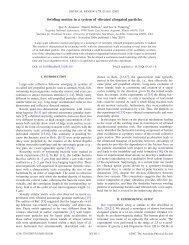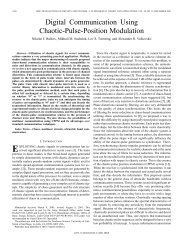A fast, robust and tunable synthetic gene oscillator - The BioCircuits ...
A fast, robust and tunable synthetic gene oscillator - The BioCircuits ...
A fast, robust and tunable synthetic gene oscillator - The BioCircuits ...
You also want an ePaper? Increase the reach of your titles
YUMPU automatically turns print PDFs into web optimized ePapers that Google loves.
doi: 10.1038/nature07389 SUPPLEMENTARY INFORMATION<br />
eliminated from JW0063, <strong>and</strong> ∆lacI was introduced into the resulting strain by P1vir phage transduction<br />
from JW0336. Double knockout transductants were selected for by growth on 50 µg/mL<br />
kanamycin, <strong>and</strong> kanamycin resistance was again eliminated as above to construct strain JS006<br />
(MG1655 ∆araC ∆lacI Kan S ). Genomic alterations were confirmed by genomic PCR (Datsenko<br />
<strong>and</strong> Wanner 2000) <strong>and</strong> sequencing. <strong>The</strong> locations of the kanamycin resistance remnants are<br />
sufficiently separated on the bacterial chromosome to prevent further recombination between<br />
deletion sites. <strong>The</strong> dual-feedback <strong>oscillator</strong> strain JS011 was constructed by transforming JS006<br />
with pJS167 <strong>and</strong> pJS169 such that the only source of AraC <strong>and</strong> LacI was the <strong>oscillator</strong> plasmids.<br />
To construct the negative feedback <strong>oscillator</strong> strain, kanamycin resistance was eliminated from<br />
JW0336 to form strain JS002 (MG1655 ∆lacI Kan S ). JS002 was then transformed with the two<br />
negative feedback <strong>oscillator</strong> plasmids described above to construct JS013.<br />
Microfluidics device construction<br />
We examined cells with single-cell timelapse fluorescence microscopy using microfluidic devices<br />
designed to support growth of a monolayer of E. coli cells under constant nutrient flow (Supplementary<br />
Fig. 2). <strong>The</strong> use of these microfluidic devices, coupled with cell tracking <strong>and</strong> fluorescence<br />
measurement, allow us to <strong>gene</strong>rate fluorescence trajectories for single cells. <strong>The</strong> design of<br />
the microfluidic device used in these experiments was adapted from the Tesla microchemostat<br />
design developed in Cookson et al. (2005) for use with Saccharomyces cerevisiae. <strong>The</strong> original Tesla<br />
microchemostat design implemented the classic Tesla diode loop (Tesla 1920; Duffy et al. 1999;<br />
Bendib <strong>and</strong> Français 2001) modified for imaging a monolayer culture of growing yeast cells. Here,<br />
modifications were made to support imaging monolayers of E. coli, which included lowering the<br />
cell chamber height from 4 µm to 1 µm to match the cylindrical diameter of K-12 MG1655 cells,<br />
lowering the delivery channel height from 12 µm to 3 µm to maintain equivalent flow splitting<br />
between the cell chamber <strong>and</strong> the bypass channel, <strong>and</strong> dividing the cell trapping region into three<br />
channels for simultaneous observation of isolated colonies (Supplementary Fig. 2A–B). Lastly, the<br />
width of each parallel chamber was limited to 30 µm so as not to exceed the width/height aspect<br />
ratio of 30 for PDMS <strong>and</strong> risk structural collapse of the chamber “ceilings.”<br />
In order to achieve long experimental runs, a critical design objective was to avoid clogging<br />
between the media port <strong>and</strong> the trapping region. Towards this end, we developed a three-port<br />
chip design in which the main channel extending from the cell port splits into a media channel<br />
<strong>and</strong> a waste channel downstream of the trapping region. <strong>The</strong> waste port receives untrapped cells<br />
during loading <strong>and</strong> superfluous media during runtime, thereby eliminating contamination of the<br />
media port. Cells were loaded into the three trapping channels of the microfluidic device by<br />
directing flow in the “forward” direction from the cell port to the waste port. Upon trapping a<br />
few cells in each region, the flow was reversed <strong>and</strong> slowed to steadily supply the cells with fresh<br />
nutrients from the media port through a combination of diffusion <strong>and</strong> advection. Cells grew<br />
exponentially to fill the channels over an experimental duration of ∼4–6 hours, while images<br />
were periodically acquired in the transmitted <strong>and</strong> fluorescent channels every 2–3 min. <strong>The</strong> open<br />
walls of the trapping region allowed for cells at the periphery of the exp<strong>and</strong>ing colonies to be<br />
swept away by the high flow in the main channel, thus permitting continuous exponential growth<br />
long after the trapping region filled. For optimal E. coli growth, chip temperature was typically<br />
www.nature.com/nature<br />
3







